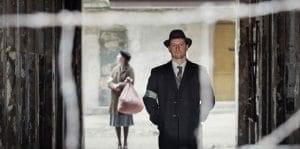
Who Will Write Our History is a part-documentary/part-feature project by acclaimed filmmaker Roberta Grossman. It is based on the book by Samuel Kassow about ‘one great act of accusation against the German policy,’ or the extraordinary story of the Oyneg Shabes archives and the brave people behind it. It aims to tell the truth as it is, mixing readings of the found documents and diaries of its protagonists over high-end dramatic-style reenactments, with interviews from experts and rarely seen historical footages. It follows the stories of Rachel Auerbach and Emanuel Ringelblum, key members of the then-secret collective project, from the beginning of WWII and the creation of the Ghetto to its destruction and the difficult recovery of the archives.
The film opens like a feature sets in 1916 with Auerbach (played by Jowita Budnik) on her way to the Warsaw Jewish area before Poland’s invasion by the Nazis. Excerpts from memoirs about her life are illustrated by past newsreels of lively and happy inhabitants of the flamboyant city flourishing with art, culture, and businesses. Soon, it shifts to a more conventional documentary with historians’ interviews informing us about Rachel herself; being a first generation Polish Jews with higher education and a leading member of the Polish Yiddish intelligentsia. She was a renowned journalist, working as an art critic and wrote extensively about the female position in contemporary society with an emphasis on Jewish women.
It predictably turns dark when it is juxtaposed with the ominous intensity of a Third Reich meeting followed by videos of the German army marching into Poland in 1939. ‘One could say we should’ve seen the worst coming…but we did not want to know the truth. We protected ourselves from the truth not wanting to see it.’; says Rachel as the footages playing reminds us of how truly incredible and powerful these real images are as opposed to what we are now accustomed to seeing in Hollywood movies.
After the invasion, we are introduced to Ringelblum (Piotr Glowacki), a historian, writer, and a public figure in the community involved in politic. He became the person in charge of organizing the relief with social welfare systems in the newly established Warsaw Ghetto (an enclosed suburb created to control and starve the Jewish population). He wanted to assemble a team of talented residents from all background and was specifically looking for Rachel. He convinced her to stay and help with the soup kitchen when she — like him — could have fled the city/country before Jews were forbidden to leave. Ringelblum told her that ‘not everybody can leave’ or is as lucky as them. Thus it is a moral duty to support their community.

“Rachel, suffering from writer’s block or fear of failing to describe her reality, realizes, like many around her, that writing was the only recourse to feel a sense of ownership of oneself in that dreadful time.”
He foresaw the terrible events that were to come, leading him to start organizing what will be a true form of resistance. His team consisted of journalists, scholars, theologists, writers, and artists imprisoned in the Ghetto. Their secret tasks were to collect and record the stories of the war from the Jewish point of view in order to create a hidden archive. Most of them operated secretly or met under the guise of Shabbat. Hence they code-named the project the Oyneg Shabes or “The Joys of Shabbat.” Among them were Herch Wasser and Abraham Lewin. Wasser was Emanuel’s executive secretary as they belonged to the same political party and the only one to know where all the archives were buried. Lewin was a religious man and a teacher. His very intimate testimonies about living in a war zone and his personal tragedies — seeing his wife being taken to a death camp, but he had ‘no force go after her to die’ — embodied the utter desolation and agonizing truth of the Ghetto residents or European Jews living under the Nazis (and their collaborators) terror.
A great portion of the documentary is rightfully dedicated to depicting the horrifying conditions in the Ghetto. Blow-by-blow accounts of the constant oppression, torments or indignities are described, starting from removals of non-German citizens from higher posts, frozen bank accounts, too, soon after, forced labor and deportations.
After ten months, Rachel, suffering from writer’s block or fear of failing to describe her reality, realizes, like many around her, that writing was the only recourse to feel a sense of ownership of oneself in that dreadful time. Between immediate shortages of fresh produces like bread (the equivalent of $60 today!) and deplorable housing conditions due to overcrowding, everyone started to write to take their minds off hunger. Powerful and sinister black & white footages appear successively depicting these abject conditions as various memories of gruesome occurrences are read. All of them more wretched and shocking than the previous about people as thin as skeletons thrown in communal graves atop mountains of corpses, rapes of daughters in front of mothers or women in a fur coat ordered by soldiers to wash the pavement with their panties and to put them back on after.
Then come the deportations en-masse and increases in executions to instill maximum fear. So, after hearing horrific news from a Chełmno extermination camp escapee, all the eyewitness accounts and collected items from drawings, posters, poems, scraps from daily life became more valuable. As more and more people were deported, the Oyneg Shabes group also realized that these would be the only pieces of evidence testifying of their realities in contrast with propaganda films showing them as dirty, filthy and ignorant people. They were determined to write their history and not be remembered as portrayed by Nazi sources.
This resonates with a piece of information mentioned by one of the interviewees, that seems primordial now, that most images from WWII that we have been exposed to were most likely taken for the propaganda, so, we see them through the German lens. That’s why they are profoundly humiliating and not showing the resilience of the oppressed. The gatherings of documents detailing some of the greatest crimes in history — which at this point in time resembled last wills and testaments written not for praise but for posterity — eventually helped prosecute the killers.

“…Great but little known story from simple proofs of everyday life and death of ordinary people in extraordinary circumstances…”
By the end, after the Great Deportation, the Ghetto Uprising and the final Nazi massacre, only 60,000 people remained in hiding or not afraid of the risks knowing their days were numbered. Only 1 in 100 Polish Jews survived the war and, of the 60 members of Oyneg Shabes, only Rachel, Hersh and his wife Bluma survived. After the liberation by the Soviets in 1945, Warsaw was unrecognizable; we learn that; ‘just finding a certain house among the rubbles was difficult,’ and so, like an archaeological expedition, it took years to recover the archive (stored in milk containers and metal boxes buried in three places).
Who Will Write Our History does a good job telling this great but little known story from simple proofs of everyday life and death of ordinary people in extraordinary circumstances. It did so with tremendous footages and reenactments of great quality featuring compelling performances, convincing visuals, first-rate music, and sound. However, the shift between the main characters felt unbalanced. The film might start and end with Rachel, but she is left out for most of it as the attention is directed towards Emanuel.
It also might have been ideal, with all the materials accessible, to rely exclusively on real accounts rather than sporadically “interrupting the movie” with experts commentaries constantly altering the mood. Admittedly, it would be tricky considering interviews add valuable information, particularly about the protagonists, that were probably not available in the required form (since all words spoken by characters came directly from the archives).
Ultimately, Who Will Write Our History, makes one wish it were a project consisting of a proper feature chronicling these fascinating acts of resistance accompanied by an in-depth documentary with real footages and explanatory interviews about the haunting events contained in the Oyneg Shabes archives.

Who Will Write Our History (2019) Directed by Roberta Grossman. Starring Jowita Budnik, Piotr Glowacki, Piotr Jankowski, Wojciech Zielinski, Karolina Gruszka, Joan Allen, Adrien Brody.
7.5/10

